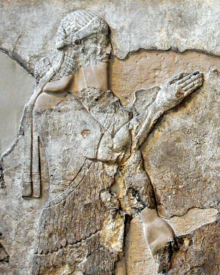
Back Salmaneser V Afrikaans 5 ስልማናሶር Amharic شلمنصر الخامس Arabic شلمنصر الخامس ARZ Salmanassar V Catalan Salmanassar V. Czech Salmaneser V Danish Salmānu-ašarēd V. German Σαλμανασέρ Ε΄ Greek Salmanasar V Spanish
| Shalmaneser V | |
|---|---|
 Possible depiction of Shalmaneser V during his time as crown prince,[1] from one of the reliefs of his father Tiglath-Pileser III | |
| King of the Neo-Assyrian Empire | |
| Reign | 727–722 BC |
| Predecessor | Tiglath-Pileser III |
| Successor | Sargon II |
| Died | 722 BC |
| Spouse | Banitu |
| Issue | Ashur-dain-aplu (?) Other children (?) |
| Akkadian | Salmānu-ašarēd |
| Dynasty | Adaside dynasty |
| Father | Tiglath-Pileser III |
| Mother | Iaba (?) |
Shalmaneser V (Neo-Assyrian cuneiform: ![]()
![]()
![]()
![]()
![]()
![]() Salmānu-ašarēd,[2][3][4] meaning "Salmānu is foremost";[3] Biblical Hebrew: שַׁלְמַנְאֶסֶר Šalmanʾeser) was the king of the Neo-Assyrian Empire from the death of his father Tiglath-Pileser III in 727 BC to his deposition and death in 722 BC. Though Shalmaneser V's brief reign is poorly known from contemporary sources, he remains known for the conquest of Samaria and the fall of the Kingdom of Israel, though the conclusion of that campaign is sometimes attributed to his successor, Sargon II, instead.
Salmānu-ašarēd,[2][3][4] meaning "Salmānu is foremost";[3] Biblical Hebrew: שַׁלְמַנְאֶסֶר Šalmanʾeser) was the king of the Neo-Assyrian Empire from the death of his father Tiglath-Pileser III in 727 BC to his deposition and death in 722 BC. Though Shalmaneser V's brief reign is poorly known from contemporary sources, he remains known for the conquest of Samaria and the fall of the Kingdom of Israel, though the conclusion of that campaign is sometimes attributed to his successor, Sargon II, instead.
Shalmaneser V is known to have campaigned extensively in the lands west of the Assyrian heartland, warring not only against the Israelites, but also against the Phoenician city-states and against kingdoms in Anatolia. Though he successfully annexed some lands to the Assyrian Empire, his campaigns resulted in long and drawn-out sieges lasting several years, some being unresolved at the end of his reign. The circumstances of his deposition and death are not clear, though they were likely violent, and it is unlikely that Sargon II was his legitimate heir. It is possible that Sargon II was entirely unrelated, which would make Shalmaneser V the final king of the Adaside dynasty, which had ruled Assyria for almost a thousand years.
Shalmaneser V is also known under the name Ululayu (![]()
![]()
![]()
![]()
![]() Ulūlāyu,[5][6][7][2][3] meaning "one who [was born] in the month Ulūlu"),[3] possibly his birth name, which is used instead of his regnal name Shalmaneser in some non-contemporary sources. Contemporary official documents from his reign exclusively refer to the king as Shalmaneser, not Ululayu, meaning that it is unlikely that the latter was ever used as an official regnal name.
Ulūlāyu,[5][6][7][2][3] meaning "one who [was born] in the month Ulūlu"),[3] possibly his birth name, which is used instead of his regnal name Shalmaneser in some non-contemporary sources. Contemporary official documents from his reign exclusively refer to the king as Shalmaneser, not Ululayu, meaning that it is unlikely that the latter was ever used as an official regnal name.
- ^ Yamada & Yamada 2017, pp. 402–403.
- ^ a b Bertin 1891, p. 49.
- ^ a b c d Yamada & Yamada 2017, p. 388.
- ^ "Salmanu-ašared [SHALMANESER V, KING OF ASSYRIA] (RN)". Open Richly Annotated Cuneiform Corpus. University of Pennsylvania.
- ^ "Ululayu [1] (PN)". Open Richly Annotated Cuneiform Corpus. University of Pennsylvania.
- ^ "Ululayu [1] (PN)". Open Richly Annotated Cuneiform Corpus. University of Pennsylvania.
- ^ "Ululayu [EPONYM OF THE YEAR 823?] (PN)". Open Richly Annotated Cuneiform Corpus. University of Pennsylvania.